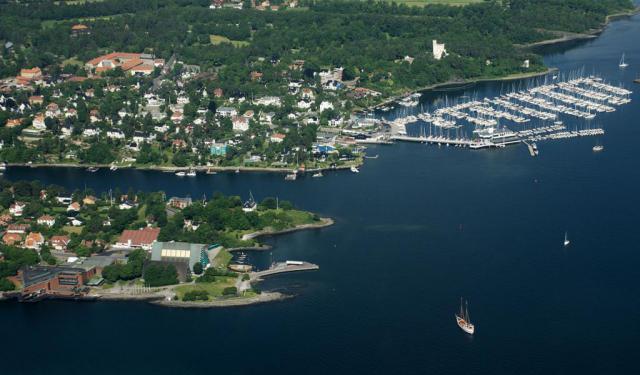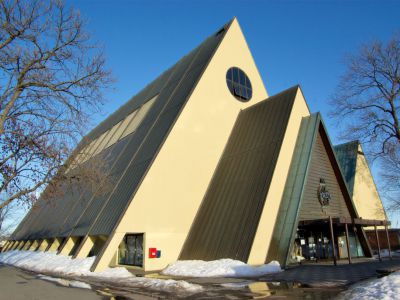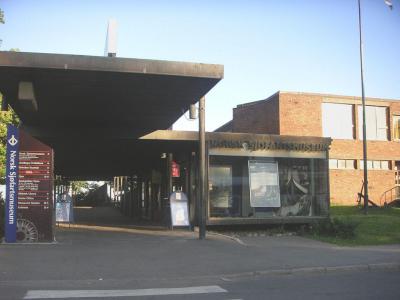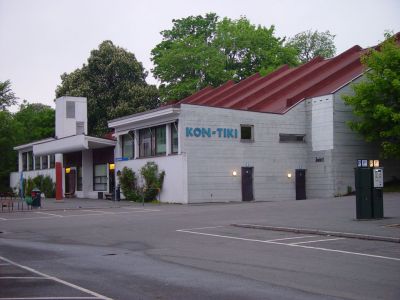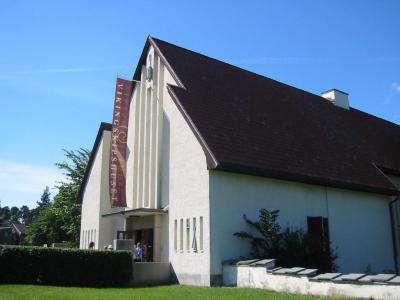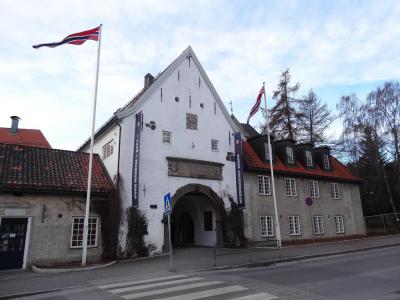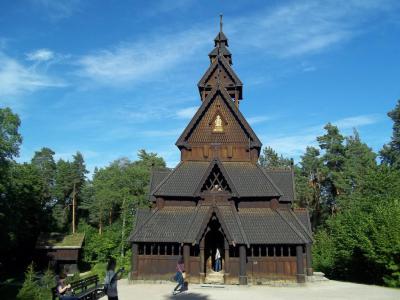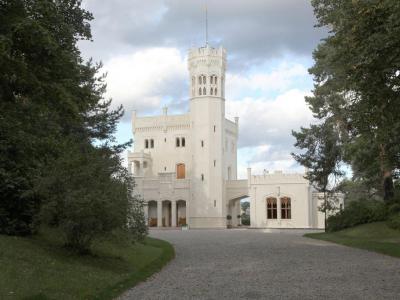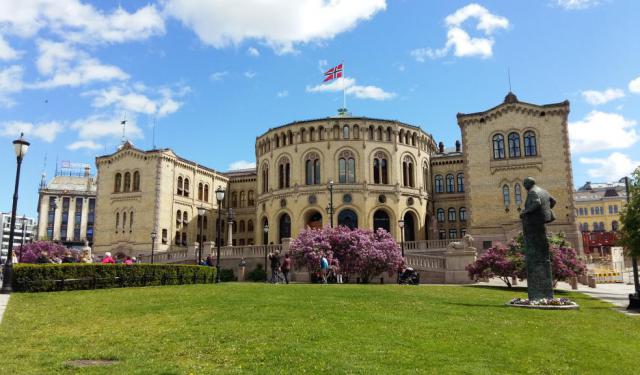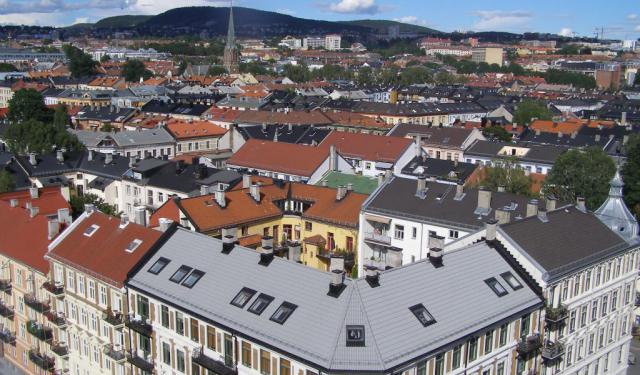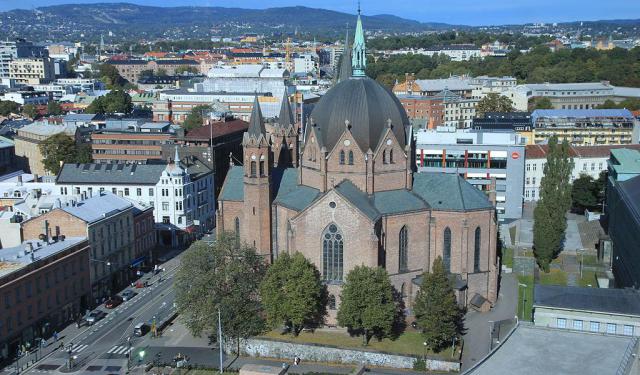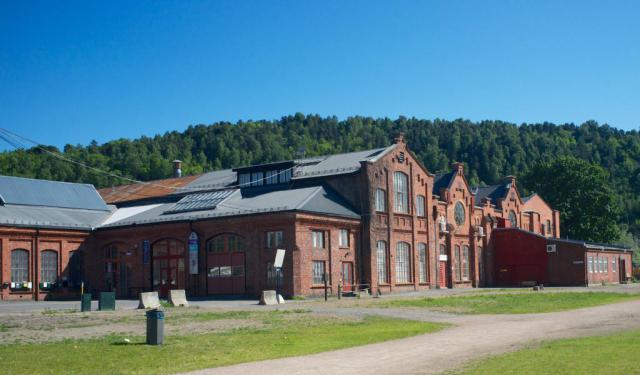Museum District (Bygdoy) Walking Tour (Self Guided), Oslo
Oslo's Museum District, located on the Bygdoy Peninsula, is home to some of the most visited museums in the city. Repositories of precious artifacts from Norway’s history, these remarkable institutions collectively represent a treasure trove for those keen on exploring this northerly nation's past.
One of the standout attractions here is the Fram Museum, showcasing the incredible polar exploration vessel, the Fram, once used by renowned explorers like Roald Amundsen. The museum's immersive exhibits take you on a thrilling journey through the frozen expanses of the Arctic and Antarctic.
Adjacent to the Fram Museum is the Norwegian Maritime Museum, where you can delve into Norway's deep-rooted maritime heritage. Exhibits here cover everything from shipbuilding to navigation, offering a comprehensive overview of the country's seafaring traditions.
The Kon-Tiki Museum is another gem in the Museum District. It celebrates the daring adventures of Thor Heyerdahl and his legendary expeditions across the Pacific on a balsa wood raft. The museum houses the actual Kon-Tiki raft and provides a fascinating insight into Heyerdahl's pioneering spirit.
For enthusiasts of Viking history, the Viking Ship Museum is a must-see. Here, you can marvel at remarkably preserved Viking ships, burial artifacts, and other relics that shed light on the Norse seafaring culture.
Moving beyond maritime history, the Norwegian Museum of Cultural History allows you to step back in time and explore traditional Norwegian life. It features historic buildings, including the iconic Gol Stave Church, which is a masterpiece of medieval wooden architecture.
Lastly, Oscarshall Castle adds a touch of regal elegance to the district. This Neo-Gothic palace, set amidst beautifully landscaped gardens, offers a glimpse into Norway's royal history.
To fully appreciate Oslo's Museum District, plan a day or two to explore these captivating venues. He who is an adventurer at heart, or simply curious about Norway's past, not to mention a true history buff, will surely find here plenty to their liking. So, come and immerse yourself in the cultural riches of Oslo's Museum District and experience the magic of Norway's heritage firsthand.
One of the standout attractions here is the Fram Museum, showcasing the incredible polar exploration vessel, the Fram, once used by renowned explorers like Roald Amundsen. The museum's immersive exhibits take you on a thrilling journey through the frozen expanses of the Arctic and Antarctic.
Adjacent to the Fram Museum is the Norwegian Maritime Museum, where you can delve into Norway's deep-rooted maritime heritage. Exhibits here cover everything from shipbuilding to navigation, offering a comprehensive overview of the country's seafaring traditions.
The Kon-Tiki Museum is another gem in the Museum District. It celebrates the daring adventures of Thor Heyerdahl and his legendary expeditions across the Pacific on a balsa wood raft. The museum houses the actual Kon-Tiki raft and provides a fascinating insight into Heyerdahl's pioneering spirit.
For enthusiasts of Viking history, the Viking Ship Museum is a must-see. Here, you can marvel at remarkably preserved Viking ships, burial artifacts, and other relics that shed light on the Norse seafaring culture.
Moving beyond maritime history, the Norwegian Museum of Cultural History allows you to step back in time and explore traditional Norwegian life. It features historic buildings, including the iconic Gol Stave Church, which is a masterpiece of medieval wooden architecture.
Lastly, Oscarshall Castle adds a touch of regal elegance to the district. This Neo-Gothic palace, set amidst beautifully landscaped gardens, offers a glimpse into Norway's royal history.
To fully appreciate Oslo's Museum District, plan a day or two to explore these captivating venues. He who is an adventurer at heart, or simply curious about Norway's past, not to mention a true history buff, will surely find here plenty to their liking. So, come and immerse yourself in the cultural riches of Oslo's Museum District and experience the magic of Norway's heritage firsthand.
How it works: Download the app "GPSmyCity: Walks in 1K+ Cities" from Apple App Store or Google Play Store to your mobile phone or tablet. The app turns your mobile device into a personal tour guide and its built-in GPS navigation functions guide you from one tour stop to next. The app works offline, so no data plan is needed when traveling abroad.
Museum District (Bygdoy) Walking Tour Map
Guide Name: Museum District (Bygdoy) Walking Tour
Guide Location: Norway » Oslo (See other walking tours in Oslo)
Guide Type: Self-guided Walking Tour (Sightseeing)
# of Attractions: 7
Tour Duration: 2 Hour(s)
Travel Distance: 3.1 Km or 1.9 Miles
Author: DanaOffice
Sight(s) Featured in This Guide:
Guide Location: Norway » Oslo (See other walking tours in Oslo)
Guide Type: Self-guided Walking Tour (Sightseeing)
# of Attractions: 7
Tour Duration: 2 Hour(s)
Travel Distance: 3.1 Km or 1.9 Miles
Author: DanaOffice
Sight(s) Featured in This Guide:
- Fram Museum
- Norwegian Maritime Museum
- Kon-Tiki Museum
- Viking Ship Museum
- Norwegian Museum of Cultural History
- Gol Stave Church
- Oscarshall Castle
1) Fram Museum (must see)
The Fram Museum stands as a tribute to Norwegian polar exploration, recounting its history and tales. Situated on the Bygdøy peninsula in Oslo, it shares space with a cluster of other remarkable museums, including the Kon-Tiki Museum, the Norwegian Museum of Cultural History, the Viking Ship Museum, and the Norwegian Maritime Museum. Nearby, one can find the Bygdøy Royal Estate, the designated summer retreat for the King of Norway, and the historic Oscarshall.
Established on May 20, 1936, the Fram Museum commemorates the broader journey of Norwegian polar exploration, with a special focus on three renowned explorers – Fridtjof Nansen, Otto Sverdrup, and Roald Amundsen. Within its walls, visitors can also encounter captivating visuals of the polar region's wildlife, including polar bears and penguins.
Central to the Fram Museum is the original exploration vessel, also named Fram. Preserving its authentic interior, the museum invites visitors to step inside the ship and witness its history firsthand. The creation of Fram was overseen by Colin Archer, a shipbuilder of Scots-Norwegian origin, who designed the vessel based on the specifications outlined by Norwegian Arctic explorer Fridtjof Nansen. In 1891, Nansen secured funding from both the Norwegian government and private sources to bring this ship to life.
In May 2009, the Fram Museum and the Norwegian Maritime Museum entered into a collaborative agreement, granting the Fram Museum the responsibility of showcasing the Gjøa, the first ship to successfully navigate the Northwest Passage. In 1906, Roald Amundsen and his crew achieved this remarkable feat after a three-year expedition. Housed in its dedicated building within the museum complex, the Gjøa was made fully accessible to visitors in 2017.
Why You Should Visit:
This museum is the most comprehensive exhibit on polar exploration that you're likely to see.
The collection includes many photographs, maps, and equipment; the displays have timelines, journal entries, and historical contents.
There are also several specific rooms that simulate the conditions in the Arctic (and the Antarctic), like the one you go in freezing and windy conditions.
The facility offers lockers, snacks, and drinks so there's no need to rush out of it.
Tip:
Consider buying the museum pack that gets you into the 3 museums all right next to each other: Fram, Kon-Tiki, and the Marine Museum.
Established on May 20, 1936, the Fram Museum commemorates the broader journey of Norwegian polar exploration, with a special focus on three renowned explorers – Fridtjof Nansen, Otto Sverdrup, and Roald Amundsen. Within its walls, visitors can also encounter captivating visuals of the polar region's wildlife, including polar bears and penguins.
Central to the Fram Museum is the original exploration vessel, also named Fram. Preserving its authentic interior, the museum invites visitors to step inside the ship and witness its history firsthand. The creation of Fram was overseen by Colin Archer, a shipbuilder of Scots-Norwegian origin, who designed the vessel based on the specifications outlined by Norwegian Arctic explorer Fridtjof Nansen. In 1891, Nansen secured funding from both the Norwegian government and private sources to bring this ship to life.
In May 2009, the Fram Museum and the Norwegian Maritime Museum entered into a collaborative agreement, granting the Fram Museum the responsibility of showcasing the Gjøa, the first ship to successfully navigate the Northwest Passage. In 1906, Roald Amundsen and his crew achieved this remarkable feat after a three-year expedition. Housed in its dedicated building within the museum complex, the Gjøa was made fully accessible to visitors in 2017.
Why You Should Visit:
This museum is the most comprehensive exhibit on polar exploration that you're likely to see.
The collection includes many photographs, maps, and equipment; the displays have timelines, journal entries, and historical contents.
There are also several specific rooms that simulate the conditions in the Arctic (and the Antarctic), like the one you go in freezing and windy conditions.
The facility offers lockers, snacks, and drinks so there's no need to rush out of it.
Tip:
Consider buying the museum pack that gets you into the 3 museums all right next to each other: Fram, Kon-Tiki, and the Marine Museum.
2) Norwegian Maritime Museum
The Norwegian Maritime Museum is situated on the Bygdøy peninsula, specifically along Bygdøynesveien on the western side of Oslo. It shares its location with various other museums, such as the Fram Museum, the Kon-Tiki Museum, the Norwegian Museum of Cultural History, and the Viking Ship Museum.
Established in 1914, the museum presents a diverse range of exhibits that delve into coastal culture and maritime history. These displays encompass a wide array of topics, including shipbuilding, boat models, fishing, marine archaeology, and shipping. Visitors can also engage with the multimedia presentation "Maritime Norway" created by Ivo Caprino, and have access to an on-site library that enhances their museum experience. The institution has a specialized marine archaeology department and displays 40+ maritime paintings by famous artists.
Among the notable vessels exhibited, the Stavanger and the Svanen take center stage. The Stavanger, designed by Colin Archer for the Norwegian Society for Sea Rescue, represents a significant contribution to maritime design. The three-masted schooner Svanen, constructed during the winter spanning 1915 to 1916, holds a history of service within the Norwegian merchant fleet.
A pivotal piece of the museum's collection is the Gjøa, which has been on display since 1972. The Gjøa holds historical importance as the vessel that successfully traversed the Northwest Passage during Roald Amundsen's Arctic expedition from 1903 to 1906. This historic ship now finds its home in a dedicated building at the Fram Museum.
Why You Should Visit:
There aren't necessarily many dazzling things to see here, but there are a lot of smaller very intricate boat models on display.
As you climb through the floors, the museum gets better and better until you reach the top where you can enjoy the interactive sailing opportunities.
There are also many informative panels that tell you all about Norwegian maritime history, world maritime trade, and world maritime customs.
Tip:
Walk about the banks of the Oslo Fjord located behind the museum.
Established in 1914, the museum presents a diverse range of exhibits that delve into coastal culture and maritime history. These displays encompass a wide array of topics, including shipbuilding, boat models, fishing, marine archaeology, and shipping. Visitors can also engage with the multimedia presentation "Maritime Norway" created by Ivo Caprino, and have access to an on-site library that enhances their museum experience. The institution has a specialized marine archaeology department and displays 40+ maritime paintings by famous artists.
Among the notable vessels exhibited, the Stavanger and the Svanen take center stage. The Stavanger, designed by Colin Archer for the Norwegian Society for Sea Rescue, represents a significant contribution to maritime design. The three-masted schooner Svanen, constructed during the winter spanning 1915 to 1916, holds a history of service within the Norwegian merchant fleet.
A pivotal piece of the museum's collection is the Gjøa, which has been on display since 1972. The Gjøa holds historical importance as the vessel that successfully traversed the Northwest Passage during Roald Amundsen's Arctic expedition from 1903 to 1906. This historic ship now finds its home in a dedicated building at the Fram Museum.
Why You Should Visit:
There aren't necessarily many dazzling things to see here, but there are a lot of smaller very intricate boat models on display.
As you climb through the floors, the museum gets better and better until you reach the top where you can enjoy the interactive sailing opportunities.
There are also many informative panels that tell you all about Norwegian maritime history, world maritime trade, and world maritime customs.
Tip:
Walk about the banks of the Oslo Fjord located behind the museum.
3) Kon-Tiki Museum (must see)
Situated on the picturesque Bygdøy peninsula, close to various other cultural landmarks and museums, is the Kon-Tiki Museum. Established in 1949 and subsequently relocated to its current site in 1957, this museum is a tribute to the life and exploits of the Norwegian adventurer Thor Heyerdahl. Born in 1914, Heyerdahl orchestrated a series of daring expeditions across the Pacific Ocean during the 1940s and 1950s. The museum draws visitors into the captivating narrative of his endeavors, particularly highlighting his renowned voyage to the South Pacific, from which the museum derives its name.
Heyerdahl possessed a profound fascination with the historical tapestry of the Pacific Islands and ardently held the conviction that pre-Columbian South American indigenous communities had established colonies in distant locales like Easter Island, well before the arrival of European explorers. Through his remarkable feat aboard the Kon-Tiki, an ingenious balsa wood raft christened after an Incan deity, Heyerdahl irrefutably demonstrated the viability of traversing the vast expanse of the Pacific. The Kon-Tiki raft, now the centerpiece of the museum's collection, symbolizes this audacious accomplishment.
The museum offers an array of captivating exhibits, including a dedicated showcase of deep-sea inhabitants, featuring the complete skeletal structure of a majestic whale shark. Additionally, an expansive library dedicated to Norwegian exploration enriches the museum's offerings, further illustrating the country's history of maritime discovery.
Why You Should Visit:
It is pretty unexpected and nice learning about something so far from Norway, but at the same time relevant to it.
The displays are interactive and well-organized and give a really good sense of the motivations and dangers behind the trip.
Tip:
Make sure you visit at midday for the daily screening of the Kon-Tiki film, which gives a better picture of what Heyerdahl and his crew achieved and definitely enhances the rest of the exhibition.
Note that there is no food available in this museum – just a coffee/tea station.
Heyerdahl possessed a profound fascination with the historical tapestry of the Pacific Islands and ardently held the conviction that pre-Columbian South American indigenous communities had established colonies in distant locales like Easter Island, well before the arrival of European explorers. Through his remarkable feat aboard the Kon-Tiki, an ingenious balsa wood raft christened after an Incan deity, Heyerdahl irrefutably demonstrated the viability of traversing the vast expanse of the Pacific. The Kon-Tiki raft, now the centerpiece of the museum's collection, symbolizes this audacious accomplishment.
The museum offers an array of captivating exhibits, including a dedicated showcase of deep-sea inhabitants, featuring the complete skeletal structure of a majestic whale shark. Additionally, an expansive library dedicated to Norwegian exploration enriches the museum's offerings, further illustrating the country's history of maritime discovery.
Why You Should Visit:
It is pretty unexpected and nice learning about something so far from Norway, but at the same time relevant to it.
The displays are interactive and well-organized and give a really good sense of the motivations and dangers behind the trip.
Tip:
Make sure you visit at midday for the daily screening of the Kon-Tiki film, which gives a better picture of what Heyerdahl and his crew achieved and definitely enhances the rest of the exhibition.
Note that there is no food available in this museum – just a coffee/tea station.
4) Viking Ship Museum (must see)
Situated on the Bygdøy peninsula in Oslo, the Viking Ship Museum forms an integral part of the Museum of Cultural History at the University of Oslo. Within its walls lie three burial ships from the Viking era, unearthed as significant archaeological discoveries from sites like Tune, Gokstad (Sandefjord), Oseberg (Tønsberg), and the Borre mound cemetery.
The museum gains its greatest renown for hosting the remarkably intact Oseberg ship, extracted from the world's largest documented ship burial. Alongside this, the Viking Ship Museum boasts the Gokstad ship and Tune ship as its main draws. Expanding the experience, the Viking Age exhibition presents an array of artifacts, encompassing sleds, beds, a horse cart, wood carvings, tent components, buckets, and various grave goods.
In 1913, Swedish scholar Gabriel Gustafson put forth a dedicated architectural concept aimed at housing Viking Age discoveries that had surfaced during the late 19th and early 20th centuries. The University of Oslo had previously offered temporary refuge to the Gokstad and Oseberg ships. An architectural competition was organized, ultimately won by Arnstein Arneberg.
The construction of the Oseberg ship hall received funding from the Norwegian Parliament, leading to the relocation of the ship from the university's provisional shelters in 1926. Subsequently, the halls for the Gokstad and Tune ships were finalized by 1932. Nonetheless, the completion of the last hall faced delays, partly due to World War II, reaching its conclusion in 1957. This final hall accommodates the majority of the other findings, primarily sourced from the Oseberg site.
Why You Should Visit:
The best place to see real Viking ships in a great conservation state and other pieces of Viking history.
The building is a wonderful setting for the ships. Pretty cheap entrance ticket as well.
Outside café and pleasant sitting out area, weather permitting.
Tip:
There's a locker you can use for free where you can put your bags, since they only allow small purses.
Your ticket also covers free entry to the Museum of Cultural History nearby within 48 hours.
The museum gains its greatest renown for hosting the remarkably intact Oseberg ship, extracted from the world's largest documented ship burial. Alongside this, the Viking Ship Museum boasts the Gokstad ship and Tune ship as its main draws. Expanding the experience, the Viking Age exhibition presents an array of artifacts, encompassing sleds, beds, a horse cart, wood carvings, tent components, buckets, and various grave goods.
In 1913, Swedish scholar Gabriel Gustafson put forth a dedicated architectural concept aimed at housing Viking Age discoveries that had surfaced during the late 19th and early 20th centuries. The University of Oslo had previously offered temporary refuge to the Gokstad and Oseberg ships. An architectural competition was organized, ultimately won by Arnstein Arneberg.
The construction of the Oseberg ship hall received funding from the Norwegian Parliament, leading to the relocation of the ship from the university's provisional shelters in 1926. Subsequently, the halls for the Gokstad and Tune ships were finalized by 1932. Nonetheless, the completion of the last hall faced delays, partly due to World War II, reaching its conclusion in 1957. This final hall accommodates the majority of the other findings, primarily sourced from the Oseberg site.
Why You Should Visit:
The best place to see real Viking ships in a great conservation state and other pieces of Viking history.
The building is a wonderful setting for the ships. Pretty cheap entrance ticket as well.
Outside café and pleasant sitting out area, weather permitting.
Tip:
There's a locker you can use for free where you can put your bags, since they only allow small purses.
Your ticket also covers free entry to the Museum of Cultural History nearby within 48 hours.
5) Norwegian Museum of Cultural History (must see)
Situated in Oslo, the Norwegian Museum of Cultural History (Norsk Folkemuseum) stands as a repository of cultural heritage. Its extensive assortment comprises artifacts from diverse societal segments and geographical regions within the country. A highlight of the museum is its expansive open-air section featuring over 150 structures sourced from urban and rural locales.
Nestled on the Bygdøy peninsula, the Norwegian Museum of Cultural History finds itself in close proximity to a cluster of fellow museums, including the Viking Ship Museum, the Fram Museum, the Kon-Tiki Museum, and the Norwegian Maritime Museum.
Originating in 1894 under the guidance of librarian and historian Hans Aall (1869–1946), the museum's inception saw the construction of temporary exhibition edifices and the relocation of numerous rural structures. The museum officially welcomed the public in 1901. In a significant development, the collections of King Oscar II, located nearby, were integrated into the museum in 1907. At its core stands a collection of five transplanted buildings, with the iconic Gol Stave Church leading the way. This ensemble is hailed as the world's inaugural open-air museum, established in 1881.
The museum features notable structures like the 13th-century Gol Stave Church, merged into Norsk Folkemuseum in 1907. Among five medieval buildings displayed, there's the 14th-century Rauland farmhouse, a tenement from 15 Wessels gate (1865) with seven flats showcasing 19th to 20th-century interiors. One flat mimics a 2002 Pakistani immigrant family's living space. In 1951, Norsk Folkemuseum acquired Sami collections from the University of Oslo's Ethnographic Museum.
Enriching its holdings, the museum boasts an expansive photographic archive, a substantial portion of which comprises works by the renowned photographer Anders Beer Wilse (1865–1949). Throughout its existence, the museum has been a hub of research, delving into areas such as architecture, furnishings, attire, textiles, technological and societal customs, agriculture, collective memory, and Sami culture.
Why You Should Visit:
To get a keen insight into Norwegian life across hundreds of years.
Tip:
Plan to spend at least 3-4 hours to give this skansen/museum justice.
It is worth taking the free guided tours (about 1h) for the interesting info about the buildings and cultural history.
Nestled on the Bygdøy peninsula, the Norwegian Museum of Cultural History finds itself in close proximity to a cluster of fellow museums, including the Viking Ship Museum, the Fram Museum, the Kon-Tiki Museum, and the Norwegian Maritime Museum.
Originating in 1894 under the guidance of librarian and historian Hans Aall (1869–1946), the museum's inception saw the construction of temporary exhibition edifices and the relocation of numerous rural structures. The museum officially welcomed the public in 1901. In a significant development, the collections of King Oscar II, located nearby, were integrated into the museum in 1907. At its core stands a collection of five transplanted buildings, with the iconic Gol Stave Church leading the way. This ensemble is hailed as the world's inaugural open-air museum, established in 1881.
The museum features notable structures like the 13th-century Gol Stave Church, merged into Norsk Folkemuseum in 1907. Among five medieval buildings displayed, there's the 14th-century Rauland farmhouse, a tenement from 15 Wessels gate (1865) with seven flats showcasing 19th to 20th-century interiors. One flat mimics a 2002 Pakistani immigrant family's living space. In 1951, Norsk Folkemuseum acquired Sami collections from the University of Oslo's Ethnographic Museum.
Enriching its holdings, the museum boasts an expansive photographic archive, a substantial portion of which comprises works by the renowned photographer Anders Beer Wilse (1865–1949). Throughout its existence, the museum has been a hub of research, delving into areas such as architecture, furnishings, attire, textiles, technological and societal customs, agriculture, collective memory, and Sami culture.
Why You Should Visit:
To get a keen insight into Norwegian life across hundreds of years.
Tip:
Plan to spend at least 3-4 hours to give this skansen/museum justice.
It is worth taking the free guided tours (about 1h) for the interesting info about the buildings and cultural history.
6) Gol Stave Church
The Gol Stave Church finds its home within the Norwegian Museum of Cultural History, situated in an open-air 'skansen' or dynamic living museum, showcasing a collection of historic structures from all corners of the nation. Originating from the early 13th century, this church embodies the architectural style of a stave church, characterized by its intricate timber-framed design with multiple tiers. While stave churches were once prevalent in medieval Scandinavia, only a handful remain unspoiled through time.
Initially erected in the quaint village of Gol in Southern Norway, the church's fate took a fortunate turn when the Society for the Preservation of Ancient Norwegian Monuments intervened in 1880. They acquired the structure, rescuing it from imminent demolition. Its journey led it to its current abode within the Museum of Cultural History. This relocation was facilitated by King Oscar II, who not only procured the church but also integrated it into his open-air museum. Over time, this merged with the church's present location.
As one of the finest-preserved timber churches in the entire country, the Gol Stave Church stands out as a remarkable highlight within the museum's offerings. Its popularity is such that a modern replica was established in its original hometown of Gol. This replica, constructed in the 1980s, pays homage to the original church that was displaced a century earlier, replaced by a new structure.
Why You Should Visit:
Great to start your learning about Norway's old churches in an intimate atmosphere.
Numerous runic inscriptions & carvings dated to the early Middle Ages can be seen inside!
Initially erected in the quaint village of Gol in Southern Norway, the church's fate took a fortunate turn when the Society for the Preservation of Ancient Norwegian Monuments intervened in 1880. They acquired the structure, rescuing it from imminent demolition. Its journey led it to its current abode within the Museum of Cultural History. This relocation was facilitated by King Oscar II, who not only procured the church but also integrated it into his open-air museum. Over time, this merged with the church's present location.
As one of the finest-preserved timber churches in the entire country, the Gol Stave Church stands out as a remarkable highlight within the museum's offerings. Its popularity is such that a modern replica was established in its original hometown of Gol. This replica, constructed in the 1980s, pays homage to the original church that was displaced a century earlier, replaced by a new structure.
Why You Should Visit:
Great to start your learning about Norway's old churches in an intimate atmosphere.
Numerous runic inscriptions & carvings dated to the early Middle Ages can be seen inside!
7) Oscarshall Castle
Oscarshall Palace finds its location nestled within the serene embrace of the Frognerkilen fjord on Bygdøy in Oslo. This elegant palace was meticulously crafted between 1847 and 1852, under the skilled guidance of Danish architect Johan Henrik Nebelong. Its creation was commissioned by King Oscar I and Queen Joséphine of Norway and Sweden. The year 1881 marked the moment when King Oscar II graciously unveiled the palace to the public as a museum.
Oscarshall Palace in Norway is a prime example of neo-Gothic architecture. It reflects the National Romantic style of its time, showcasing its captivating beauty. The palace, park, and ancillary buildings were all crafted by Norwegian artists and craftsmen. Inside, the dining hall features works by artists like Joachim Frich, Adolph Tidemand, and Hans Gude. The drawing room captures the ambiance of old Norwegian guildhalls.
In 1863, King Carl IV gave up Oscarshall to Norway. In 1929, plans arose to make it Crown Prince Olav and Princess Märtha's home, but obstacles like money and politics stopped this. Fritz Wedel Jarlsberg solved this by offering his estate, Skaugum. Now, the palace is state-owned and used by the current monarch.
Throughout the summer season, the palace doors swing open to welcome guided tours. The year 2013 witnessed the inauguration of the Queen Joséphine Gallery on the palace grounds, an initiative spearheaded by Queen Sonja. This gallery serves as a platform for exhibiting graphic prints, showcasing noteworthy works including those crafted by Her Majesty herself during its inaugural season.
Oscarshall Palace in Norway is a prime example of neo-Gothic architecture. It reflects the National Romantic style of its time, showcasing its captivating beauty. The palace, park, and ancillary buildings were all crafted by Norwegian artists and craftsmen. Inside, the dining hall features works by artists like Joachim Frich, Adolph Tidemand, and Hans Gude. The drawing room captures the ambiance of old Norwegian guildhalls.
In 1863, King Carl IV gave up Oscarshall to Norway. In 1929, plans arose to make it Crown Prince Olav and Princess Märtha's home, but obstacles like money and politics stopped this. Fritz Wedel Jarlsberg solved this by offering his estate, Skaugum. Now, the palace is state-owned and used by the current monarch.
Throughout the summer season, the palace doors swing open to welcome guided tours. The year 2013 witnessed the inauguration of the Queen Joséphine Gallery on the palace grounds, an initiative spearheaded by Queen Sonja. This gallery serves as a platform for exhibiting graphic prints, showcasing noteworthy works including those crafted by Her Majesty herself during its inaugural season.
Walking Tours in Oslo, Norway
Create Your Own Walk in Oslo
Creating your own self-guided walk in Oslo is easy and fun. Choose the city attractions that you want to see and a walk route map will be created just for you. You can even set your hotel as the start point of the walk.
Oslo Introduction Walking Tour
Originally a Viking village, Norway's capital city has a long and multifaceted history that begins long before its establishment as a trading hub of Ánslo in 1040 AD. Archaeological findings suggest the presence of a Christian settlement in the area predating the year 1000.
Throughout the Middle Ages, Oslo's significance varied under the rule of Danish and Norwegian kings. Around... view more
Tour Duration: 2 Hour(s)
Travel Distance: 4.1 Km or 2.5 Miles
Throughout the Middle Ages, Oslo's significance varied under the rule of Danish and Norwegian kings. Around... view more
Tour Duration: 2 Hour(s)
Travel Distance: 4.1 Km or 2.5 Miles
Grunerlokka Walking Tour
Once a gritty, working-class corner of Oslo, Grunerlokka has undergone the classic glow-up-trading in factory soot for flat whites and vegan tacos. Named after Friedrich Gruner, a 17th-century city official who probably never imagined his name would one day grace a district with more tattoo parlors than churches, this neighborhood has turned from industrial to the capital’s cool kid on the block... view more
Tour Duration: 1 Hour(s)
Travel Distance: 2.5 Km or 1.6 Miles
Tour Duration: 1 Hour(s)
Travel Distance: 2.5 Km or 1.6 Miles
Historical Churches Walking Tour
Oslo's religious landscape, particularly within the Christian tradition, is a captivating tapestry interwoven with history, faith, and architectural elegance. The city boasts a collection of historical churches reflecting the evolution of local Christian communities. Diverse in their designs, these sacred sites offer a glimpse into the deep-rooted religious traditions that have shaped Oslo... view more
Tour Duration: 1 Hour(s)
Travel Distance: 1.2 Km or 0.7 Miles
Tour Duration: 1 Hour(s)
Travel Distance: 1.2 Km or 0.7 Miles
Old Oslo Walking Tour
The historic Old Town of Oslo is the oldest part of the city which dates back to the days of medieval Norway. This urban area emerged around the year 1000 and became the capital of Norway's dominion (within the Dano-Norwegian Realm) around 1300. The Old Town district continued to be known as Oslo, while the whole city was called Christiania, until 1925.
One of its prominent landmarks is... view more
Tour Duration: 1 Hour(s)
Travel Distance: 1.4 Km or 0.9 Miles
One of its prominent landmarks is... view more
Tour Duration: 1 Hour(s)
Travel Distance: 1.4 Km or 0.9 Miles
Useful Travel Guides for Planning Your Trip
Traveler's Choice: 15 Norwegian Gifts from Oslo
The Norwegians are strict about gift making and believe that each gift must be equaled with a return one. For this reason, public holidays and birthdays are a very serious business in Norway, with everyone making and receiving gifts. In the spirit of this tradition, you might want to treat your dear...
The Most Popular Cities
/ view all
